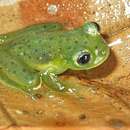Description
(
Inglês
)
fornecido por AmphibiaWeb articles
Cochranella ritae is a small glass-frog (19mm in SVL) that belongs to the Cochranella spinosa species group (Savage 2002). Head large. Snout rounded, truncated. Vomerine teeth present. Eyes large (1 mm), directed to front; eye diameter equal to the distance between the tip of the snout and the eye. Tympanum very small, almost 1/6 of the eye diameter. A short ridge runs from the posterior corner of the eye to above the tympanum. Fingers free and wide, with finger discs very large (1 mm). Subarticular tubercles regular. Inner metatarsal tubercles small, rounded; outer metatarsal tubercle absent. Legs very long and broad. Surface of the skin smooth. Coloration in preservative: pale-yellow, with black dots on the head and the sacral region. Upper eyelids black (Lutz and Kloss 1952).The epithet of this species is a patronym for Gertrud Rita Kloss, a research assistant of Dr. Bertha Lutz in the Museu Nacional-RJ and the collector of the holotype. The species was known only from the holotype, collected in 1950 and formerly housed in the Museu Nacional, Rio de Janeiro, but which is now lost or destroyed (Cisneros-Heredia and McDiarmid 2007). These authors considered C. ritae more similar to C. ametarsia than to C. resplendens, and pointed out that “in fact, C. ametarsia may be a synonym of C. ritae” (Cisneros-Heredia and McDiarmid 2007). A photograph of C. ametarsia from Departamento de Loreto was presented by Bartlett and Bartlett (2003), but erroneously reported as C. ritae (Torres-Gastello et al. 2007).
- Lutz, B. and Kloss, G. R. (1952). ''Anfíbios anuros de alto Solimões e Rio Negro.'' Memórias do Instituto Oswaldo Cruz, 50, 625-678.
- Torres-Gastello, C.P., Suarez-Segovia, J., and Cisneros-Heredia, D.F. (2007). ''Cochranella erminea, a new species of Centrolenidae (Amphibia: Anura: Athesphatanura) from Amazonian Peru.'' Journal of the National Museum (Prague), Natural History Series, 176(1), 1-12.
- autor
- Diogo Borges Provete
Distribution and Habitat
(
Inglês
)
fornecido por AmphibiaWeb articles
The species was described from the city of Benjamin Constant (4° 22’ 38”S, 70° 01’ 47” W), at the boundary among Brazil, Peru and Colombia, where it presumably occurs. Benjamin Constant is a city at the confluence of the Javari River and the Solimões River, at 77m a.s.l. (High Solimões River region). No specific locality was presented at the time of species description, though it is likely that the specimen came from the woodlands in the surroundings of the city. The area is part of the Central Amazonia eco-region (Lutz and Kloss 1952).
- autor
- Diogo Borges Provete
Life History, Abundance, Activity, and Special Behaviors
(
Inglês
)
fornecido por AmphibiaWeb articles
The only specimen collected was obtained in April or June (the end of the rainy season) of 1950 by Gertrud Rita Kloss, a naturalist assistant from the Museu Nacional-RJ, during a field expedition of that museum to the High Solimões River region (Lutz and Kloss 1952). Kloss pointed out that the woodlands of the region at the time of specimen collection were cleared, and looked like a “capoeira” (open formation inside forest) rich in trees with narrow trunks and lianas. Further information on habitat requirements, reproductive biology, vocalizations and tadpole are needed to correctly assess the conservation status of this taxon. C. ritae probably reproduces by laying an egg mass on the surface of a leaf, like other members of the C. spinosa species group.
- autor
- Diogo Borges Provete
Life History, Abundance, Activity, and Special Behaviors
(
Inglês
)
fornecido por AmphibiaWeb articles
Unknown. It presumably occurs in one national reserve, RPPN (Reserva Particular do Patrimônio Natural), in Benjamin Constant.
- autor
- Diogo Borges Provete

